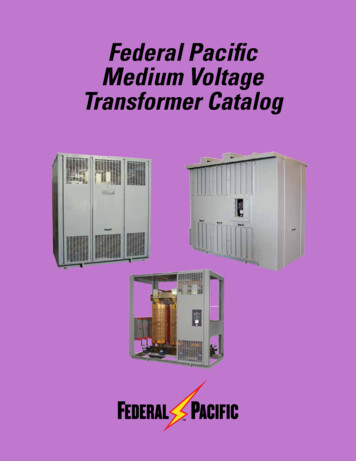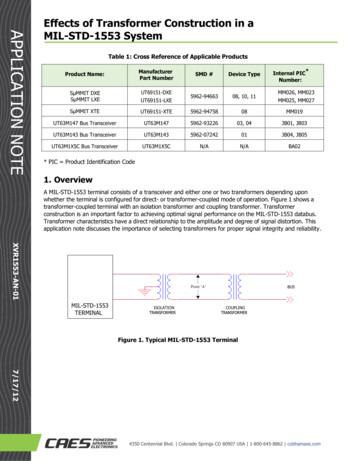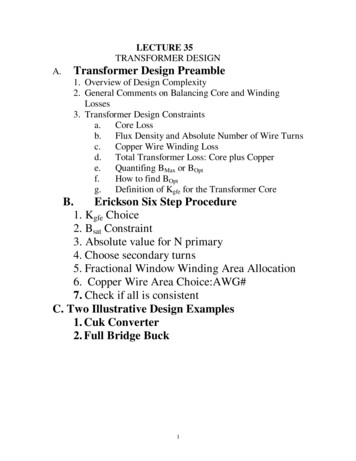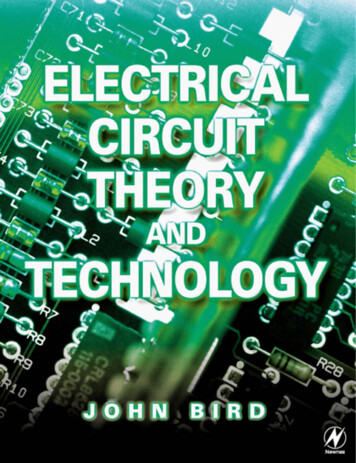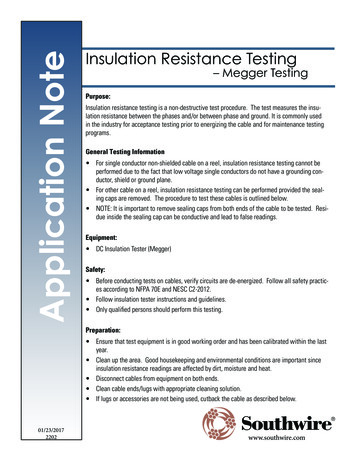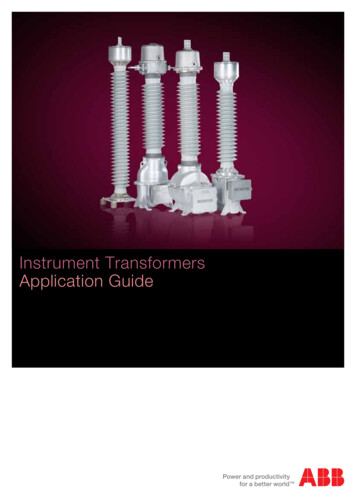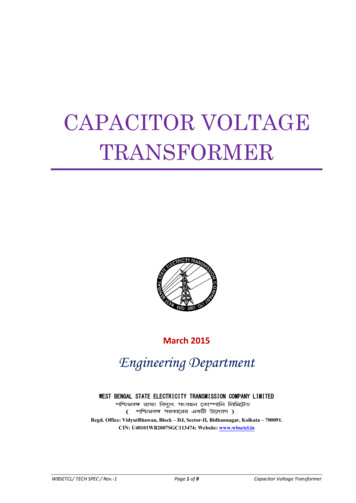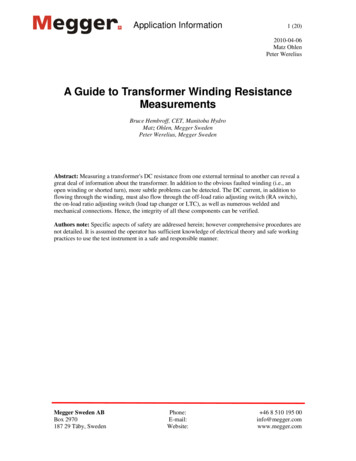
Transcription
Application Information1 (20)2010-04-06Matz OhlenPeter WereliusA Guide to Transformer Winding ResistanceMeasurementsBruce Hembroff, CET, Manitoba HydroMatz Ohlen, Megger SwedenPeter Werelius, Megger SwedenAbstract: Measuring a transformer's DC resistance from one external terminal to another can reveal agreat deal of information about the transformer. In addition to the obvious faulted winding (i.e., anopen winding or shorted turn), more subtle problems can be detected. The DC current, in addition toflowing through the winding, must also flow through the off-load ratio adjusting switch (RA switch),the on-load ratio adjusting switch (load tap changer or LTC), as well as numerous welded andmechanical connections. Hence, the integrity of all these components can be verified.Authors note: Specific aspects of safety are addressed herein; however comprehensive procedures arenot detailed. It is assumed the operator has sufficient knowledge of electrical theory and safe workingpractices to use the test instrument in a safe and responsible manner.Megger Sweden ABBox 2970187 29 Täby, SwedenPhone:E-mail:Website: 46 8 510 195 00info@megger.comwww.megger.com
Application Information2 (20)2010-04-06Matz OhlenPeter WereliusContent1Introduction . 31.1 General . 31.2 Winding resistance measurements (WRM) . 32 Winding Resistance Measurements – When? . 32.1 At Installation . 32.2 At Routine (scheduled) Transformer Maintenance . 42.2.1Ratio Adjusting Switch (ratio adjusting off-load tap changer) . 42.2.2Load Tap Changer . 42.3 At Unscheduled Maintenance/Troubleshooting. 42.4 At Internal Transformer Inspections . 53 Test Equipment . 54 Measurement principle . 55 Safety Considerations . 75.1 AC Induction. 75.2 DC Test Current . 75.3 Summary of Safety Precautions . 76 Selecting the Proper Current Range . 87 Measurements . 87.1 RA Switch Measurements. 97.2 LTC Measurements. 98 Connections. 108.1 General . 108.2 Star/Wye Windings . 108.3 Delta Windings . 109 Interpretation of Measurements . 119.1 Confusion Factors . 119.1.1Temperature change . 119.1.2Contact oxidization . 129.1.3A measuring error . 129.2 How Bad is Bad? . 1210Isolating Problems . 1310.1RA Switch . 1310.2LTC . 1310.3Step Switch Observation . 1310.4Reversing Switch Observation . 1310.5Diverter Switch Observation . 1410.6Contacts vs. Connectors or Joints . 1411Limitations. 1412Figures and Tables. 1513References . 20Megger Sweden ABBox 2970187 29 Täby, SwedenPhone:E-mail:Website: 46 8 510 195 00info@megger.comwww.megger.com
Application Information3 (20)2010-04-06Matz OhlenPeter WereliusA Guide to Transformer Winding ResistanceMeasurements1 Introduction1.1 GeneralThis application note is focusing on using winding resistance measurements (WRM) for diagnosticpurposes. The intention of this reference manual – application guide is to guide the operator in theappropriate method of making winding resistance measurements on power transformers and assist in theinterpretation of test results obtained. It is not a complete step-by-step procedure for performing tests andis not replacing the user manual for the actual instrument. Before performing any test with aninstrument, read the user manual and observe all safety precautions indicated.1.2 Winding resistance measurements (WRM)Winding resistance measurements in transformers are of fundamental importance for the followingpurposes: Calculations of the I2R component of conductor losses.Calculation of winding temperature at the end of a temperature test cycle.As a diagnostic tool for assessing possible damage in the field.Transformers are subject to vibration. Problems or faults occur due to poor design, assembly,handling, poor environments, overloading or poor maintenance. Measuring the resistance of thewindings assures that the connections are correct and the resistance measurements indicate that thereare no severe mismatches or opens. Many transformers have taps built into them. These taps allow theratio to be increased or decreased by fractions of a percent. If any of the ratio changes involve amechanical movement of a contact from one position to another, these tap changes should also bechecked during a winding resistance test.Regardless of the configuration, either star or delta, the measurements are normally made phase tophase and comparisons are made to determine if the readings are comparable. If all readings are withinone percent of each other, then they are acceptable. Keep in mind that the purpose of the test is not toduplicate the readings of the manufactured device, which was tested in the factory under controlledconditions and perhaps at other temperatures.2 Winding Resistance Measurements – When?2.1 At InstallationRisk of damage is significant whenever a transformer is moved. This is inherent to the typicaltransformer design and modes of transportation employed. Damage can also occur during unloadingand assembly. The damage will often involve a current carrying component such as the LTC, RAMegger Sweden ABBox 2970187 29 Täby, SwedenPhone:E-mail:Website: 46 8 510 195 00info@megger.comwww.megger.com
Application Information4 (20)2010-04-06Matz OhlenPeter Wereliusswitch or a connector. Damage to such components may result in a change to the DC resistancemeasured through them. Hence, it is recommended that the DC resistance be measured on all on-loadand off-load taps prior to energizing.If the transformer is new, the resistance test also serves as a verification of the manufacturers work.Installation measurements should be filed for future reference2.2 At Routine (scheduled) Transformer MaintenanceRoutine maintenance is performed to verify operating integrity and to assure reliability. Tests areperformed to detect incipient problems. What kind of problems will the resistance test detect?2.2.1 Ratio Adjusting Switch (ratio adjusting off-load tap changer)Contact pressure is usually obtained through the use of springs. In time, metal fatigue will result inlower contact pressure. Oxygen and fault gases (if they exist) will attack the contact surfaces.Additionally, mechanical damage resulting in poor contact pressure is not uncommon. (E.g. Amisaligned switch handle linkage may result in switch damage when operated). Such problems willaffect the DC resistance measured through the RA switch and may be detected.2.2.2 Load Tap ChangerThe LTC contains the majority of the contacts and connections in the transformer. It is one of few nonstatic devices in the transformer and is required to transfer load current several thousand times a year.Hence, it demands special consideration during routine maintenance.In addition to detecting problems associated with high resistance contacts and connectors, the Meggerwinding tester will also detect open circuits (drop-out test). LTCs transfer load current. An opencircuit would likely result in catastrophic failure. On installation and after maintenance it is certainlyprudent to verify operating integrity by checking for open circuits. LTC maintenance often involvesconsiderable disassembly and the test will provide confidence in the reassembly.It is recommended DC resistance measurements be made on all on-load and off-load taps to detectproblems and verify operating integrity of the RA switch and LTC.2.3 At Unscheduled Maintenance/TroubleshootingUnscheduled Maintenance generally occurs following a system event. The objectives of unscheduledmaintenance are: To detect damage to the transformer.To determine if corrective action is necessary.To establish priority of corrective action.To determine if it is safe to re-energize.Many transformer faults or problems will cause a change in the DC resistance measured from thebushings (shorted turns, open turns, poor joints or contacts). Hence, the information derived from theresistance test is very useful in analyzing faults or problems complimenting information derived fromother diagnostic tests such as FRA, DFR, power factor and other measurements. The windingMegger Sweden ABBox 2970187 29 Täby, SwedenPhone:E-mail:Website: 46 8 510 195 00info@megger.comwww.megger.com
Application Information5 (20)2010-04-06Matz OhlenPeter Wereliusresistance test is particularly useful in isolating the location of a fault or problem and assessing theseverity of the damage.2.4 At Internal Transformer InspectionsInternal inspections are expensive due primarily to the cost of oil processing. When such opportunitiesdo present themselves the inspection should be planned and thorough. Prior to dumping the oil, allpossible diagnostic tests including the resistance test should be performed.3 Test EquipmentPrior to modern digital electronic equipment, the Kelvin Bridge was used. Batteries, switches,galvanometers, ammeters and slide-wire adjustments were used to obtain resistance measurements.Current regulators were constructed and inserted between the battery and the bridge. Input voltage tothe regulator of 12 volts dc from an automobile storage battery provided output currents variable insteps which matched the maximum current rating of the bridge on the ranges most used ontransformers. The current regulator increased both speed and accuracy of the bridge readings. Theapproximate 11 volt availability was used to speed up the initial current build-up and tapered off toabout 5 volts just before the selected current was reached and regulation started. When the regulationbegan, the current was essentially constant in spite of the inductance of the windings and fluctuation ofthe battery voltage or lead resistance.The testing times have been greatly reduced using modern microprocessor based test equipment.Direct readings are available from digital meters and on some testers like the Megger MTO series,two measurement channels are available allowing two resistance measurements at the same time.4 Measurement principleWinding resistance is measured with the following setup;A DC test current is injected across the measured winding (-s), the voltage drop as well as the testcurrent is measured and the resistance is calculated.Megger Sweden ABBox 2970187 29 Täby, SwedenPhone:E-mail:Website: 46 8 510 195 00info@megger.comwww.megger.com
Application Information6 (20)2010-04-06Matz OhlenPeter WereliusFor purely resistive objects the measurement is trivial and very easy to perform. However, when themeasurement circuit is highly inductive, the so called “simple application” may become rathercomplex. The mathematical expressions, where U is Voltage, R is resistance, I is current, Φ is flux, Lis inductance and t is the time, to describe the measurement are;U R I dφ ( I , t )dtU R I d [L( I , t ) I (t )]dtU R I L L( I , t ) φ (I , t)I I (t ) L(t ) I t tWhere the first term is the winding resistance R times the current I, i.e. what we want to measure. Thesecond term is the voltage caused by change of current, i.e. the Ldi/dt term, and the third term iscaused by change of inductance with time; the magnetic properties of the core does not only dependson current level and history (hysteresis), it also depends on time.The second “error” term, inductance x change of current, is well known and the solution to this issue isto keep the test current constant over time. The third “error” term, current x inductance change, ismuch more difficult to reduce or compensate for. In practice the only way is to wait for the inductancechange to stabilize. This third term in the equation is what may cause very long measurement time toperform WRM on large LV delta configured windings, see section 7 and 8.3.The time-variable parameters in the winding resistance measurement are described in the followingdiagrams.To the left: Illustration of Voltage, Current and Apparent resistance as function of time. To the right:A typical hysteresis curve for a magnetic material, e.g. transformer core. The Inductance L isproportional to the slope of the curve when current is changedMegger Sweden ABBox 2970187 29 Täby, SwedenPhone:E-mail:Website: 46 8 510 195 00info@megger.comwww.megger.com
Application Information7 (20)2010-04-06Matz OhlenPeter WereliusGenerally, to minimize influence of above described physics; avoid low flux densities in legs involvedin measurement and try to reach saturation flux in the core. As a rule of thumb, saturation is achievedat around 1% of the rated current of the winding.5 Safety ConsiderationsWhile performing winding resistance tests, hazardous voltages could appear on the terminals of thetransformer under test and/or the test equipment if appropriate safety precautions are not observed.There are two sources to consider; AC induction from surrounding energized conductors, andthe DC test current.5.1 AC InductionWhen a transformer is located in an A-C switch yard in close proximity to energized conductors it isquite probable that electrostatic charge would be induced onto a floating winding. This hazard can beeliminated by simply tying all windings to ground. However, to perform a winding resistance test,only one terminal of any winding can be tied to ground. Grounding a second terminal will short thatwinding under test and would probably result in measuring the resistance of the ground loop. Twogrounds on a winding which is not under test will create a closed loop inductor. Because all windingsof a transformer are magnetically coupled, the DC test current will continually circulate within theclosed loop inductor (the shorted winding). The instrument display would probably not stabilize andaccurate measurements would not be possible.It does not matter which terminal is grounded as long there is only one terminal of each winding tiedto ground. When test leads are moved to subsequent phases or windings on the transformer it is notnecessary to move the ground connections. Ensure the winding is grounded prior to connecting thecurrent and potential test leads, and when disconnecting leads, remove the ground last.5.2 DC Test CurrentShould the test circuit become open while DC current is flowing, hazardous voltages (possiblyresulting in flash over) will occur. Care must be taken to ensure the test circuit does not accidentallybecome open: Ensure the test leads are securely attached to the winding’s terminals.Do not operate any instrument control which would open the measured circuit while DCcurrent is flowing. Discharge the winding first.Do not disconnect any test leads while DC current is floating. Ensure the winding isdischarged first.When terminating the test, wait until the discharge indicator on the Megger winding testergoes off before removing the current leads. When testing larger transformers it may take 30seconds or more to discharge the winding. If a longer time (30 second plus) is required tocharge a winding when the current is initiated a corresponding longer time will be required todischarge the winding.5.3 Summary of Safety PrecautionsEnsure all transformer windings and the test instrument chassis are grounded prior to connecting thetest leads.Megger Sweden ABBox 2970187 29 Täby, SwedenPhone:E-mail:Website: 46 8 510 195 00info@megger.comwww.megger.com
Application Information8 (20)2010-04-06Matz OhlenPeter WereliusTake appropriate precautions to ensure the test circuit is not open while DC (test) current is flowing.Failure to take appropriate precautions can result in hazardous potentials which could be harmful toboth personnel and test equipment. It should be noted that the transformer windings are essentiallylarge inductors. The higher the voltage produced and the larger the (MVA) capacity, the higher theinduction and hence the potential hazard.6 Selecting the Proper Current Range Always try to saturate the core. This happens typically when the test current is about 1% ofrated currentNever exceed 10% of rated current. This could cause erroneous readings due to heating of thewindingTypical test currents are from about 0.1% to a few percent of rated currentIf test current is too low, measured resistance is not consistent (pending magnetic status beforethe test is started) and a specific winding will have different readings when measured fromtime to timeNote: If MTO indicates input voltage overload or does not charge the transformer with the selectedtest current, you have selected a test current 10%. Select next lower current range and restart.7 MeasurementsWait until the display has stabilized prior to recording resistance values. Generally, readings on a starconfigured transformer should stabilize in 10-30 seconds after the test current has stabilized. However,the time required for readings to stabilize will vary based on the rating of the transformer, the windingconfiguration, and the current output selected. On large transformers with high inductance windings itcould take a minutes for readings to stabilize.For large transformers with LV delta configuration, magnetization and getting stable readings can takesubstantially longer time (see Figure 4), sometimes as long as 30-60 minutes. If the readings don’tstabilize close to expected value within a reasonable measurement time, check leads, connections andinstrument. It may be necessary to inject current on HV and LV windings simultaneously(recommended!), see example in Figure 3-6 and table 1. Read and record the winding temperatureRecord measurements as read. Do not correct for temperature.Do not calculate individual winding values for delta connected transformers.Record the selected DC test currentRecord unit of measure (ohms or milli-ohms).Review test data. Investigate and explain all discrepancies.As a general rule, the first measurement made is repeated at the end of the test. Consistent first and lastreadings give credibility to all measurements. Whenever an unexpected measurement is obtained boththe test method and procedure are questionable. If the measurement can be repeated the doubt isremoved. In situations where time is of concern, the repeat measurement can be omitted if allmeasurements are consistent.Megger Sweden ABBox 2970187 29 Täby, SwedenPhone:E-mail:Website: 46 8 510 195 00info@megger.comwww.megger.com
Application Information9 (20)2010-04-06Matz OhlenPeter WereliusAlways check the winding schematic on the nameplate, and trace the current path(s) through thewindings. The nameplate vector representative may be misleading. Also, check the location of groundson the windings and ensure the grounds do not shunt the DC test current.When a winding has both an RA switch (ratio adjusting off-load tap changer) and an LTC (load tapchanger) take measurements as follows: With the LTC on neutral, measure resistance on all off-load taps.With the RA switch on nominal /rated tap, measure resistance on all on-load taps.7.1 RA Switch MeasurementsThe recommended procedure for testing RA switches is as follows: Prior to moving the RA switch, measure the resistance on the as-found tap. Note: Thismeasurement is particularly useful when investigating problems.Exercise the switch by operating it a half dozen times through full range. This will removesurface oxidization. See “Interpretation of Measurements – Confusion Factors”.Measure and record the resistance on all off-load taps.Set the RA switch to the left tap and take one final measurement to ensure good contact. Donot move the RA switch after this final measurement has been made.7.2 LTC Measurements“As-found” measurements are performed for diagnostic purposes in routine and non- routinesituations. “As-left” measurements are performed to verify operating integrity following work on theLTC. The resistance test on a transformer with an LTC is time consuming; hence the value of the “asfound” test in each particular situation should be evaluated. Consider maintenance history and design.Certainly, if the proposed work involves an internal inspection (main tank) or a problem is suspectedthe “as-found” test should be performed.Prior to taking “as-left” measurements, exercise the LTC. Operating the LTC through its full range oftaps two to six times should remove the surface oxidation.When testing windings with LTCs, be sure to use tap-changer setup/sequential testing on theinstrument so the measurement value of each tap is stored separately. The current generator is onthroughout the test sequence while changing from tap to tap.Measure and save the resistance for the first tap. Operate LTC. Measure for the second tap and savethe resistance value. Operate LTC. Measure resistance for the third tap etc.Should the LTC open the circuit and cause current interruption, the Megger MTO will automaticallyindicate open connection and if the interruption is longer than about 10 ms, the unit will stop and gointo its discharge cycle. This gives the operator a clear indication by a panel light of a possible faultwithin the tap changer. Such transformers should not be returned to service as catastrophic failurewould be possible.Megger Sweden ABBox 2970187 29 Täby, SwedenPhone:E-mail:Website: 46 8 510 195 00info@megger.comwww.megger.com
Application Information10 (20)2010-04-06Matz OhlenPeter Werelius8 Connections8.1 GeneralPrior to connecting the instrument leads to the transformer, all transformer windings must begrounded. See Safety Considerations. Make connections in the following order:1. Ensure windings terminals are not shorted together and tie to ground (the transformer tank)one terminal of the transformer winding to be tested. Note: It does not matter which terminalis grounded (a line terminal or neutral) as long as only one terminal on each winding isgrounded.2. Ensure the instrument’s power switch is in the off position and connect it to the mains supply.Note: The instrument’s chassis is grounded through the supply cable to the station service.(On occasion it has not been possible to stabilize the measurement when the instrument’schassis ground was not connected to the same ground point as the winding (i.e., thetransformer tank) This problem is most likely to occur when the station service ground is notbonded to the transformer tank and is easily remedied by connecting a jumper between theinstrument chassis and the transformer tank.)3. Connect the test leads to the instrument.4. Connect the test leads to the transformer winding. The potential leads must be connectedbetween the current leads or use kelvin clips. Do not clip the potential leads to the currentleads. Observe polarity.5. Upon completion of the test, ensure the winding is discharged before disconnecting any testleads. Remove the ground from the transformer winding last.Caution: Do not open the test circuit in any way (i.e. disconnecting test leads, or operating the currentselector switch) while DC current is flowing. Hazardous voltages (probably resulting in flash-over) willoccur.Note: A three phase test set will make suitable connections to the windings by internally switching themeasuring leads.8.2 Star/Wye WindingsRefer to figures 1-3 and Table 1. Measuring two windings simultaneously is possible if a suitablecommon test current can be selected. Take resistance measurements with the indicated connections.Connecting the test equipment as per figure 3 is the preferred method because it allows the operator tomeasure two phases simultaneously. Compared to measuring each phase individually there is asignificant time savings particularly when measuring a winding with an LTC.If time is of concern the last test set up, which is a repeat of the first, may be omitted if all measurementsare consistent when comparing one phase to the next or the previous tests.8.3 Delta WindingsRefer to Figures 1-2 and Table 1. If there is a delta configured LV, always try to inject test current inHV and LV simultaneously (and measure two windings). This will magnetize the core more efficientlyand shorten the time to get stable readings. If single-injection single-channel measurement is chosen,please note that the time for stabilization on larger transformers may be long!Megger Sweden ABBox 2970187 29 Täby, SwedenPhone:E-mail:Website: 46 8 510 195 00info@megger.comwww.megger.com
Application Information11 (20)2010-04-06Matz OhlenPeter WereliusTake a resistance measurement with the indicated connections. Again, if time is of concern the last testset up, which is a repeat of the first, may be omitted if all measurements are consistent whencomparing one phase to the next or to the previous tests.9 Interpretation of MeasurementsMeasurements are evaluated by: Comparing to original factory measurementsComparing to previous field measurementsComparing one phase to anotherPhase to phase comparisons will usually suffice. The industry standard (factory) permits a maximumdifference of 0.5% from the average of the three phase windings. Field readings may vary slightlymore than this due to the many variables. If all readings are within 1% of each other, then they areacceptable.Comparing absolute resistance values in the field with factory values may be difficult due to theproblem of exactly estimating the winding temperature. Values within 5% are normally acceptable.Variation from one phase to another or inconsistent measurements can be indicative of many differentproblems: Shorted turnsOpen turnsDefective ratio adjusting (RA) switch or LTCPoor connections (brazed or mechanical)The winding resistance test is very useful in identifying and isolating the location of suspectedproblems.9.1 Confusion FactorsApparent problems (i.e., inconsistent measurements or variations between phases) can also be theresult of a number of factors which are not indicative of problems at all. Failure to recognize thesefactors when evaluating test data can result in confusion and possibly unwarranted concern.9.1.1 Temper
A Guide to Transformer Winding Resistance Measurements Bruce Hembroff, CET, Manitoba Hydro Matz Ohlen, Megger Sweden Peter Werelius, Megger Sweden Abstract: Measuring a transformer's DC resistance from one external terminal to another can reveal a great deal of information about the transformer. In addition to the obvious faulted winding (i.e., an

